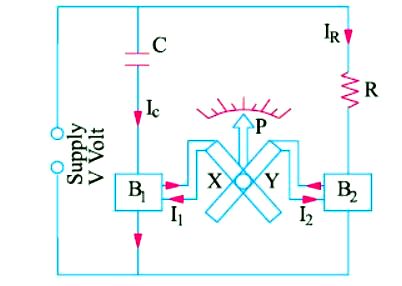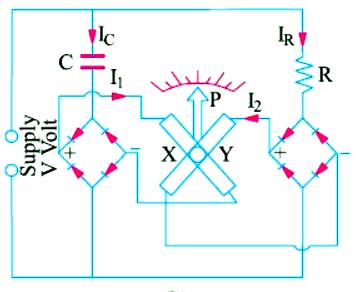Electrodynamic Frequency Meter
Electrodynamic Frequency Meter is also referred to as moving-coil frequency meter and is a ratiometer type of instrument.
Working Principle of Electrodynamic Frequency Meter:
The working principle may be understood from Figure A which shows two moving coils rigidly fixed together with their planes at right angles to each other and mounted on the shaft or spindle situated in the field of a permanent magnet. There is no mechanical control torque acting on the two coils. If G1 and G2 are displacement constants of the two coils and I1 and I2 are the two currents, then their respective torques are T1 = G1 I1 cos θ, T2 = G2 I2 sin θ. These torques act in the opposite directions.
Obviously, T1 decreases with θ where as T2 increases but an equilibrium position is possible for same angle θ for which
G1 I1 cos θ = G2 I2 sin θ
or

By modifying the shape of pole faces and the angle between the planes of the two coils, the ratio I1/I2 is made proportional to angle θ instead of tan θ. In that case, for equilibrium θ ∝ I1/I2.

Construction of Electrodynamic Frequency Meter:
The circuit connections are shown in Figure B & C. The two ratiometer coils X and Y are connected across the supply lines through their respective bridge rectifiers. The direct current I1 through coil X represents the R.M.S. value of capacitor current IC as rectified by B1. Similarly, direct current I2 flowing through Y is the rectified current IR passing through series resistance R.
AdBlock-2


Working Principle of Electrodynamic Frequency Meter:
When the meter is connected across supply lines, rectified currents I1 and I2 pass through coils X and Y they come to rest at an angular position where their torques are equal but opposite. This angular position is dependent on the supply frequency which is read by a pointer attached to the coil.
As proved above, θ ∝ I1/I2
Assuming sinusoidal waveform, mean values of I1 and I2 are proportional to the R.M.S. values of IC and IR respectively.

where Vm is the maximum value of the supply voltage whose equation is assumed as v = Vm sin ωt.
![]()
Obviously, such meters have linear frequency scales. Moreover, since their readings are independent of voltage, they can be used over a fairly wide range of voltage although at too low voltages, the distortions introduced by rectifier prevent an accurate indication of frequency.
It will be seen that the range of frequency covered by the meter depends on the value of R and C and these may be chosen to get ranges of 40–60 Hz, 1200–2000 Hz or 8000–12,000 Hz.
Read article – Units of Resistivity
Visit NCERTplanet.com for NCERT solutions and Textbook downloads




